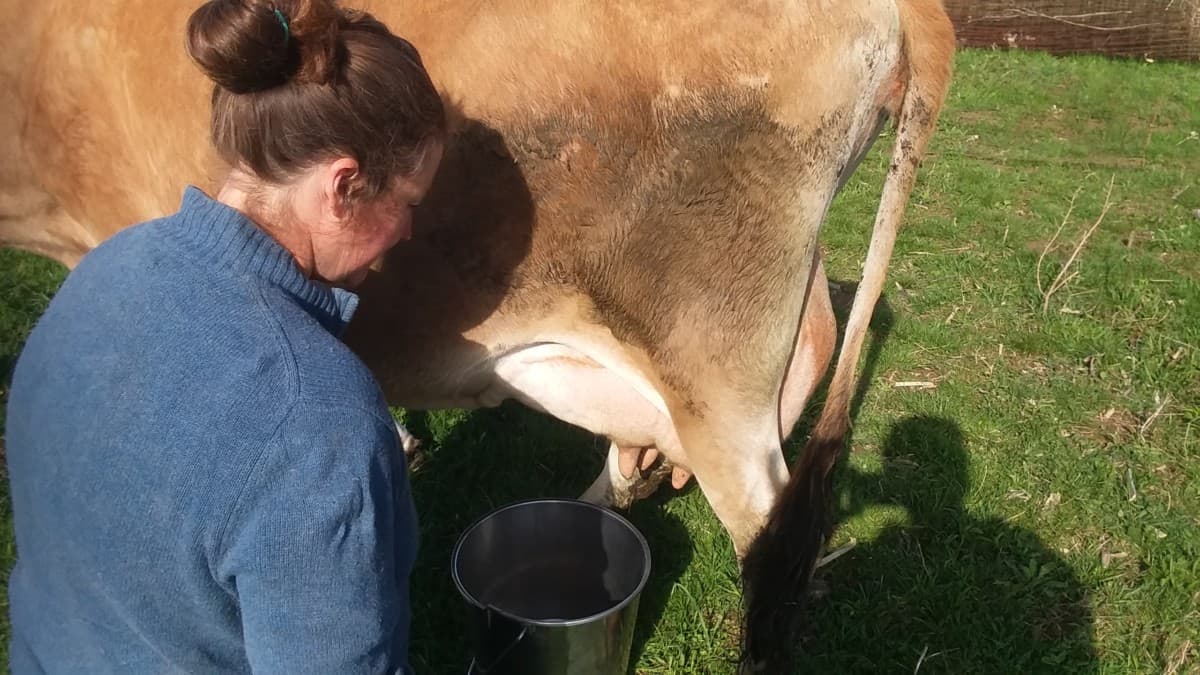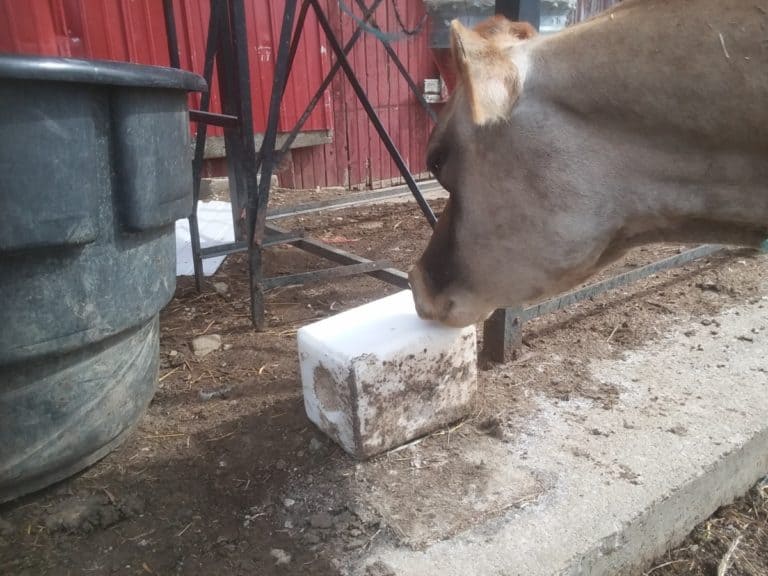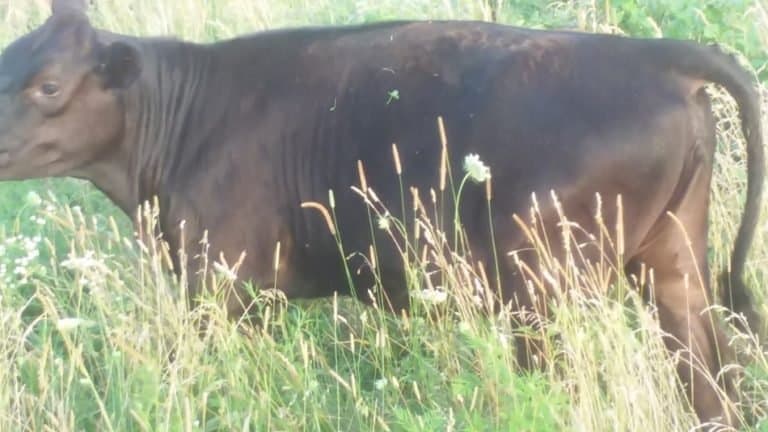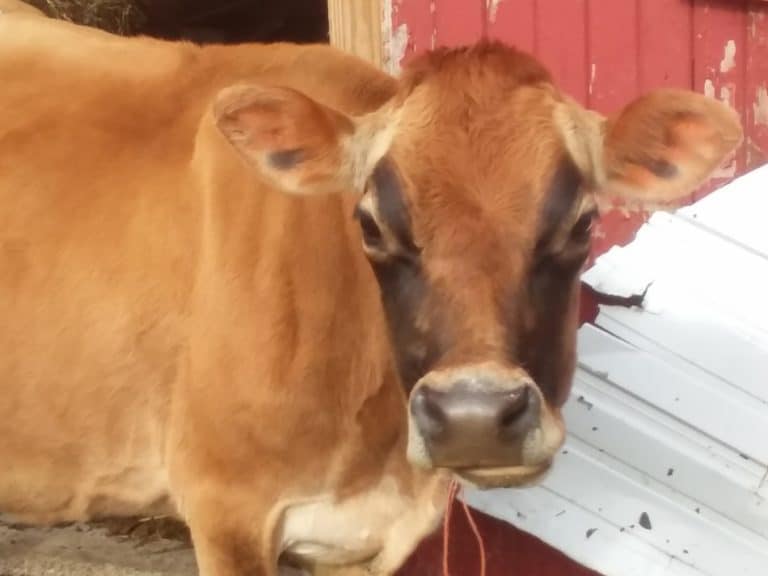How To Hand Milk A Cow: 8 Easy Steps To Having Your Own Milk!

Interested in learning how to hand milk a cow? I’ve got you covered! With some basic instruction and a bit of practice you’ll be good to go!
Hand milking a cow requires that you have a bucket and a place to sit or kneel beside the cow. Have place to tie the cow, clean the udder (if needed) then milk into a clean bucket. After milking, dip the teats (if needed), untie the cow then strain and refrigerate the milk in a glass container.
How do you know if you’re ready? My guide “Are You Ready For A Family Cow?” will walk you through the things you need to have figured out, including feeding needs and daily care, before you get your cow.
Hand milking a cow is a very relaxing 10 minutes or so for the cow as well as the person milking the cow.
Everyone has their own spin on how and when to milk the cow but the basics remain the same. It’s actually easy to do once you build up the arm/hand strength.
5 Best Dairy Breeds For A Family Milk Cow goes over my top choices for your family cow.
Family Milk Cow Feeding Plan will go over what to feed your cow and how to tell if she needs more or less to eat.
The milking process has 8 steps
There are 8 steps to take in order to milk a cow.
- Gather your clean equipment
- Tie the cow (most cows need tied)
- Prep the udder
- Start milking front quarters
- Milk back quarters
- Post milking teat dip
- Let the cow loose
- Strain the milk and refrigerate it
Gather up your clean equipment
The milking equipment you use must be clean, every time. Stainless steel is best for the bucket.
Tie the cow if she won’t reliably stand for milking
Most cows need to be tied for milking because they will walk away continuing to graze or keeping going to where ever she thinks she needs to go next.
She can be tied up by a halter or just a neck collar. We use a neck collar. Aleene normally does not need tied, but we have the collar on for the few times she is uncooperative.
If you have a specific stall where you want to milk her at give her a reason to like coming into this area.
Have a snack waiting for her like a small amount of grain or nice hay. Even if she doesn’t need it, this little bit of bribery will make her want to cooperate!

The more she enjoys coming into the milking stall the easier your life will be. Have her stall be a calm relaxing place that she knows will be to her benefit to go into.
Cows love routine. When she knows the milking area or stall is a nice place where good things happen, she’ll be eager to go in and get her snack.
Prep the udder before milking
Many people do a pre milking dip or wipe the udder with a warm towel that has a bit of soap on it.
We don’t do either under normal circumstances, we just start milking.
If she has managed to get her udder dirty with caked on mud or she sat in poop, now you need at least a towel to wipe off any debris that might fall into the milk.
Plus it is a good idea to get dirt or poo off of her udder, otherwise her skin will dry out and crack.
If she does have dry skin on her teats and udder a moisturizing dip will help her skin become more supple and keep her (and you) happy at milking time.
Start milking front quarters
Many people strip the first few squirts of milk into a cup with a screen on top to see how the milk looks.
You can do this if you want, but we don’t. If there is a problem with the milk you will be able to see it.
If you are worried, just put the first few squirts of milk on the ground, then start filling the pail.
We start with the front quarters alternately squeezing until they are empty.
You will be able to tell the quarter is empty since the quarter will start full, she lets down her milk and you milk until you end up with soft skin and no more milk. That quarter is done.
The hand motion is to put the hand up to the udder like you are holding a cup to drink out of, so your palms are facing you.
Pick a hand to start with. Now pinch together your thumb and first finger, this seals off the teat canal so the milk goes down and not up!
Now squeeze down with your fingers in order, middle, ring and last finger. Milk should stream out into the bucket. Now repeat with the other hand.
Keep alternating back and forth between hands until all the the milk from those two quarters is in the bucket.

Milk the back quarters after the front quarters
Now move your hands to the back two teats and start over, alternating milk streams until she is done.
You should be able to reach both sets of teats from one position, but if you can’t then just scootch over a bit until you can reach.
Now go back to the front two teats and get any milk that has come in and redo a few squirts out of the back as well. Milking is done!
Slide the pail out of the way so she doesn’t tip it and you don’t get any of the teat dip (next step) in the milk.
Sometimes the quarters are uneven milk producers
Sometimes your cow will have quarters that produce different amounts of milk.
Right now, Aleene is really going down in milk in her left front quarter, which makes milking the front two teats very uneven, time wise.
To even up the milking, so I end at the same time for all of the quarters, I switch around teats to do my best to finish up the whole udder at the same time.
Currently, this means spending the most time on the back left, since this quarter produces the most milk and milking the other quarters as needed to ideally finish up at the same time.
If your cow has an uneven quarters/milk production, you’ll learn which quarters are the high producers, one that you start on early in milking, and which ones you need to spend less time on since they are producing less.
Family Cow Milk Production goes over the lactation curve for your best girl, so you know how much milk to expect!
Post milking is the time for teat dip
The post milking dip is to keep the teats supple and stop any bacteria from entering the teat canal. Stay on top of this one.
If her skin on her teats starts to get dry or irritated your life as a hand milker just got harder. Maybe a lot harder, since she will get kicky.
You can use a dip formulated for cows or just vegetable oil. Make sure it is made to moisturize the skin.
Here’s an article that heavily supports teat dipping your cow. Read it and see what you think.
As far as the bacteria goes, if she has a clean area where she can lay down then she is much less likely to have a problem with bacteria entering into the open end of the teat.
The teat end has a sphincter muscle that keeps the teat canal closed and this takes a bit of time to tighten back up, especially if the teat end was injured.
This muscle being closed is why the first few squirts of milk are harder to get out than the rest, the muscle is closed but relaxes open as soon as you or a calf starts needing milk.
We don’t do this post milking teat dip step either, as long as the teats look super healthy.
As soon as we see a hint of dry skin she gets dipped using some vegetable oil I bought specifically for her, but normally no post dip.
Whether you need to post dip or not just depends upon you and your cow.
If you got her from a place that uses dips it’s going to be best for both of you to keep using the program that works for her.
How do you know if you’re ready? My guide “Are You Ready For A Family Cow?” will walk you through the things you need to have figured out, including feeding needs and daily care, before you get your cow.
Turn the cow loose after milking is done
Now that you are done milking turn her loose to go roam about for the rest of the day until evening milking.
If she learns that the milking stall is a trap she will be less likely to want to come in when you need to milk her later. Keep her happy and give her some freedom.
The exceptions here would be ice and extreme heat. If you are dealing with either of these, consider keeping her in for the day.
Cows do not walk well on ice, keep her in if she has to cross an icy driveway. Her feet are not built to handle ice, she’ll slip and fall on the ice.
Then you will have to figure out how to get her up and back inside. Don’t do this to her or yourself, just keep her in for the day.
On extremely hot days she should be where ever it is coolest.
Heat is hard on cows, meaning it will raise her stress and lower her milk production. Help her deal with it by giving her a comfortable place to relax.
Strain the milk and refrigerate it
The milk is now ready to be strained to keep out any debris.
After you strain the milk into a clean, glass jar, refrigerate the milk right away.
Since the milk is raw (alive) and at room temperature the natural bacteria in it will start turning it sour if you leave the milk out at room temperature.
If you like soured milk, leave it out. If not, stick that jar in the fridge!
It takes 8-10 minutes to milk a cow by hand
Generally it takes 8-10 minutes, but this varies by the cow and the stage of lactation she is in. Some cows milk out faster than others.
If she is just fresh (just had a baby) then her milk supply will increase through about 6 weeks then start to taper off.
For instance, our current family cow will milk any where from 2-4 gallons per day depending upon feed and stage of lactation.
More milk equals more time to do the milking.
Milk your cow twice a day
Family Cow Daily Care goes over a routine and care for your cow.
Most cows are milked twice a day at 12 hour intervals, for example 8 a.m. and 8 p.m.
You could milk more often if you choose, but the times need spread out evenly.
Many people choose to just milk once per day and let the calf nurse for the rest of the day.
This requires penning the calf separately from the cow overnight or the calf will get to the morning milk before you!
You can milk from either side of the cow
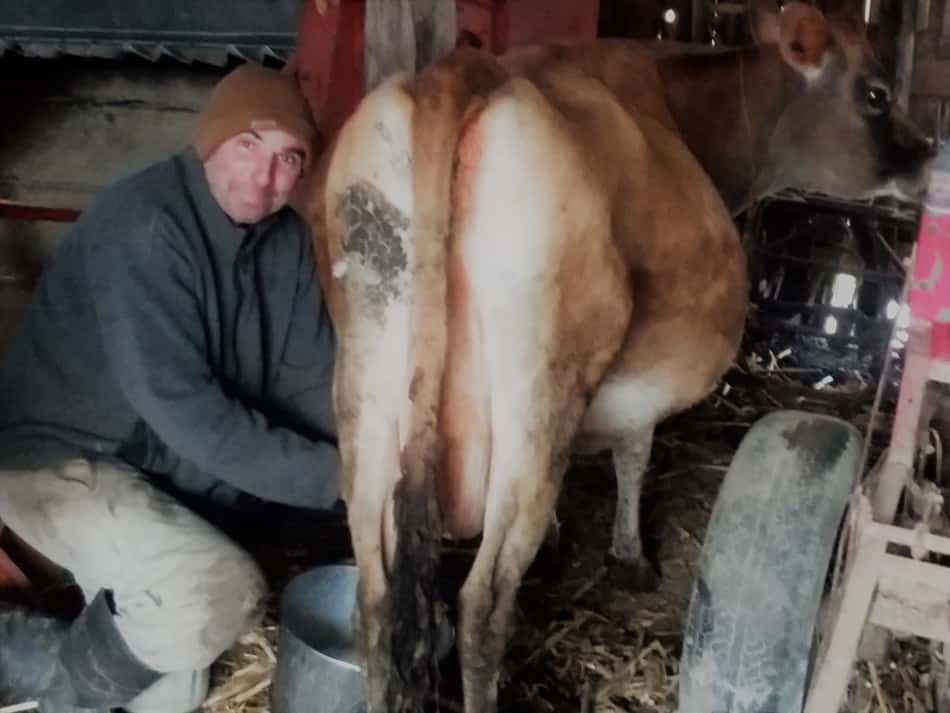
We milk Aleene from her left side. For some reason my husband and I both like to milk from the left side better.
I’ve tried the right side and it just feels awkward to me, but that’s just me.
Really, the important one here is the cow, if she is used to being milked on the left, then milk her on the left or vice versa.
Considering getting a family cow and would like some more information to help you? Click here for my article on selecting a family cow.
Timewise, a person can milk 4-5 cows per hour by hand
In theory, a person could milk 4-5 cows by hand per hour. Notice the “in theory” part here! Milking by hand for an hour would be tough.
Each cow should take about 8-10 minutes to milk, plus a bit of time in between each cow to dump the pail into the dumping station (this pumps the milk to the tank) or milk can.
The total time to milk will depend upon how fast she lets down her milk and how much total milk she has.
But in reality the limiting factor is going to be how long can the milker keep going, you would have to work up to doing all of these cows yourself!
I know I wouldn’t be able to milk our cow twice in a row, my arms and hands aren’t used to it.
We know several Amish men who hand milk a small herd of Holstein cattle and then sell the milk in cans.
The average seems to be that he can milk 8 Holsteins in about 2 hours if he does all of the cows himself.
How do you know if you’re ready? My guide “Are You Ready For A Family Cow?” will walk you through the things you need to have figured out, including feeding needs and daily care, before you get your cow.
Related Questions
Do cows get hurt when milked?
Not at all, my cow seems to find milking to be very relaxing. She just chews her cud during milking (a stressed cow doesn’t chew her cud).
Do cows produce milk if they are not pregnant?
Cows produce milk after their calf is born. She has to be pregnant first, then have a baby, then she will produce milk.
Until she has a calf, she can not produce any milk.
